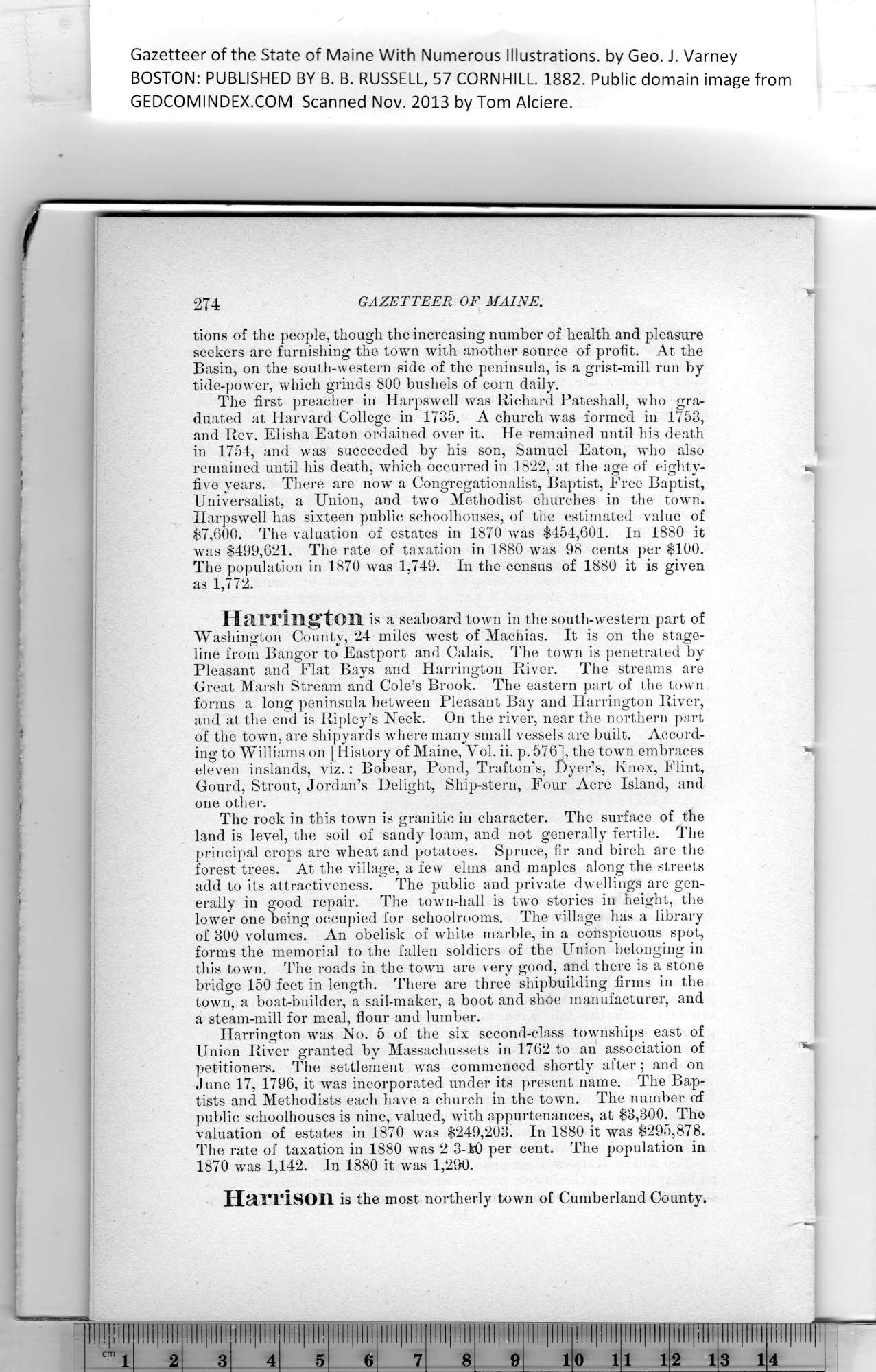|
Gazetteer of the State of Maine With Numerous Illustrations, by Geo. J. Varney
BOSTON: PUBLISHED BY B. B. RUSSELL, 57 CORNHILL. 1882. Public domain image from
274 GAZETTEER OF MAINE.
tions of the people, though the increasing number of health and pleasure
seekers are furnishing the town with another source of profit. At the
Basin, on the south-western side of the peninsula, is a grist-mill run by
tide-power, which grinds 800 bushels of corn daily.
The first preacher in Harpswell was Richard Pateshall, who gra-
duated at Harvard College in 1735. A church was formed in 1753,
and Rev. Elisha Eaton ordained over it. He remained until his death
in 1754, and was succeeded by his son, Samuel Eaton, who also
remained until his death, which occurred in 1822, at the age of eighty- ».
five years. There are now a Congregationalist, Baptist, Free Baptist,
Universalist, a Union, and two Methodist churches in the town.
Harpswell has sixteen public schoolhouses, of the estimated value of
$7,600. The valuation of estates in 1870 was $454,601. In 1880 it
was $499,621. The rate of taxation in 1880 was 98 cents per $100.
The population in 1870 w’as 1,749. In the census of 1880 it is given
as 1,772.
Harrington is a seaboard town in the south-western part of
Washington County, 24 miles west of Machias. It is on the stage-
line from Bangor to Eastport and Calais. The town is penetrated by
Pleasant and Flat Bays and Harrington River. The streams are
Great Marsh Stream and Cole’s Brook. The eastern part of the town
forms a long peninsula between Pleasant Bay and Harrington River,
and at the end is Ripley’s Neck. On the river, near the northern part
of the town, are shipyards where many small vessels are built. Accord-
ing to Williams on [History of Maine, Vol. ii. p. 576], the town embraces M,
eleven inslands, viz.: Bobear, Pond, Trafton’s, Dyer’s, Knox, Flint,
Gourd, Strout, Jordan’s Delight, Ship-stern, Four Acre Island, and
one other.
The rock in this town is granitic in character. The surface of the
land is level, the soil of sandy loam, and not generally fertile. The
principal crops are wheat and potatoes. Spruce, fir and birch are the
forest trees. At the village, a few elms and maples along the streets
add to its attractiveness. The public and private dwellings are gen-
erally in good repair. The town-hall is two stories in height, the
lower one being occupied for schoolrooms. The village has a library
of 300 volumes. An obelisk of white marble, in a conspicuous spot,
forms the memorial to the fallen soldiers of the Union belonging in
this town. The roads in the town are very good, and there is a stone
bridge 150 feet in length. There are three shipbuilding firms in the
town, a boat-builder, a sail-maker, a boot and shoe manufacturer, and
a steam-mill for meal, flour and lumber.
Harrington was No. 5 of the six second-class townships east of
Union River granted by Massachussets in 1762 to an association of
petitioners. The settlement was commenced shortly after; and on
June 17, 1796, it was incorporated under its present name. The Bap-
tists and Methodists each have a church in the town. The number of
public schoolhouses is nine, valued, with appurtenances, at $3,300. The
valuation of estates in 1870 was $249,203. In 1880 it was $295,878.
The rate of taxation in 1880 was 2 3-10 per cent. The population in
1870 was 1,142. In 1880 it was 1,290.
HarriSOn is the most northerly town of Cumberland County.
PREVIOUS PAGE ... NEXT PAGE
This page was written in HTML using a program written in Python 3.2
|
